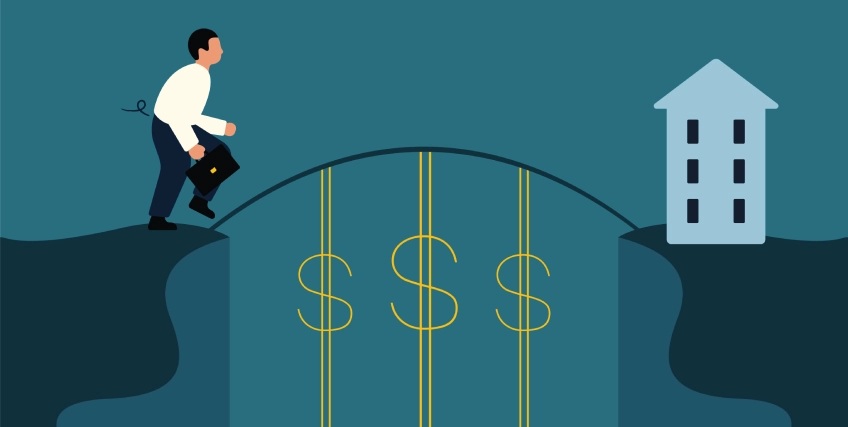Bridge Loans vs. Business Lines of Credit: Which is Better for Temporary Gaps?
Jun 11, 2025 | Last Updated on: Jun 16, 2025

Small business owners deal with many challenges that can cause gaps in cash flow. From payment delays from customers to seasonal downturns, and unpredictable causes like market dips or a factory accident, there are many potential reasons business owners could be forced to look for an emergency infusion of capital.
However, not all bridge financing is the same. Two of the most common types of gap funding are business bridge loans and business lines of credit. Each may have advantages for your particular situation, but it’s important to understand how each works so you can make the right decision for your unique business needs.
In this article:
- Learn what you need to know about business bridge loans and lines of credit.
- Understand the pros and cons of business bridge loans and lines of credit.
- Discover why one financing solution may be better than the other based on your specific needs.
What Is a Bridge Loan?
Also known as interim financing, gap financing, or bridging loans, a business bridge loan is a short-term loan used to “bridge the gap” when your business needs capital, but permanent financing is not yet available. Borrowers use bridge loans to meet their current financial obligations and working capital needs until they can pay off existing debts or become eligible for a more permanent type of financing.
Business bridge loans typically have higher interest rates than traditional ones and often have to be backed by some form of collateral. For instance, if your business is upgrading a manufacturing facility, you could get a business bridge loan to purchase a new property and begin moving, then use the proceeds from selling the previous property to secure a more permanent commercial property loan. {Although, in this instance, real estate bridge loans are typically only available to borrowers with an excellent credit score and low debt-to-income (DTI)} ratio.
Another instance in which a business might use a business bridge loan is when they’re waiting for longer-term financing through an equity funding round. Bridge loan lenders may customize a loan option for a business to cover working capital needs like payroll, rent, and utilities until the business receives the expected funding. Then, the business repays the loan amount.
Pros and Cons of Business Bridge Loans
Bridge loans work similarly to traditional small business loans and have some of the same advantages and drawbacks. However, there are some particularities that make them uniquely suited to fill cash flow gaps and somewhat less desirable funding options than others.
Pros:
- Application processes tend to be faster than traditional loans.
- You can get a bridge loan from a traditional lender, online lender, or a bridge loan company.
- They offer short-term cash flow that provides the flexible financing you need while awaiting more permanent funding solutions.
- Allow you to establish a relationship with a lender that may support future loans.
Cons:
- Typically have higher interest rates than other types of business loans.
- Often require collateral or a down payment.
- You may wind up having to make monthly payments on two loans if the new financing doesn’t pay off the bridge loan.
What Is a Business Line of Credit?
A business line of credit is a form of flexible financing that combines the features of a traditional term loan and a business credit card. When you apply, you’re approved for a maximum loan amount that you can withdraw from when you need to make business purchases. However, you pay interest only on the amount you withdraw, not the entire loan amount. You can usually access funds through your business bank account or mobile app.
Business lines of credit work differently from other types of business loans. Rather than receive a lump sum upfront and have a regular repayment schedule, lines of credit are typically revolving, which means once you pay what you’ve borrowed, plus interest and fees, you’ll have access to the full loan amount again, like a credit limit.
Lines of credit may be available for short-term financing or longer-term depending on your interest and availability from the lender. Loan amounts tend to be smaller than traditional funding due to the frequency with which you can access the funds, and interest rates and fees tend to be higher. However, a working line of credit can be a very flexible, fast-funding option when you have temporary gaps in cash flow or expect to have gaps throughout a calendar year.
Secured vs. Unsecured Business Lines of Credit
When you get a business line of credit, it will be either secured or unsecured. A secured line of credit requires collateral, such as equipment, real estate, or inventory to back the loan. The lender may seize these assets if you fail to repay the loan. Secured capital lines of credit typically have more favorable terms and a lower interest rate.
An unsecured business line of credit is not backed by collateral. It typically requires a good credit score, time in business and consistent or growing annual revenue. As these may tend to be riskier for lenders, they have higher interest rates.
The U.S. Small Business Administration (SBA) also offers lines of credit through the popular 7(a) loan program and the SBA CAPLines program.
Pros and Cons of Business Lines of Credit
Like a business bridge loan, a line of credit can be a valuable short-term funding solution. However, it’s not without drawbacks.
Pros:
- Support flexible cash flow throughout the loan term.
- Typically have lenient eligibility requirements compared to business bridge loans.
- Allow you to establish a relationship with a lender that may support future loans.
- Help you build business credit as on-time payments are reported to credit bureaus.
Cons:
- Between annual fees, withdrawal fees, and origination fees, business lines of credit may have a higher cost of borrowing than expected.
- Require consistent monitoring of your business finances to ensure you don’t withdraw more than you can pay back in a timely manner.
- Often have short repayment terms, such as six to 18 months.
Should I Get a Business Bridge Loan or Line of Credit?
Deciding between a business bridge loan or line of credit for your business will likely come down to a few factors:
- Your funding needs: If you need funding for a very specific purpose, like purchasing a property or covering expenses while you await a funding round, a business bridge loan may make sense. If you have more open-ended or unpredictable business needs and expect to tap into capital regularly, a line of credit is a better option.
- Your business profile: Small business owners with bad personal credit or bad business credit will probably get better terms on a business line of credit than a business bridge loan.
- The size of your expenses: Business lines of credit tend to work better for businesses with frequent, small to moderate expenses. A business bridge loan will likely offer a higher loan amount for the short-term.
- Urgency: Business lines of credit typically have faster funding times than business bridge loans.
Final Thoughts
Businesses can’t always predict when they might need a fast infusion of capital to support gaps in cash flow or working capital. Both business bridge loans and business lines of credit may help businesses navigate sudden cash crunches or plan for expected business downturns. While bridge loans are great solutions when you’re looking to move your business from a specific point A to point B, like bridging a gap between a major contract getting paid or opening a new storefront, business lines of credit are better for smaller, ongoing capital line of credit needs.
FAQs About Business Bridge Loans
What is the difference between a business loan and a business line of credit?
The primary difference between loans and lines of credit is that loans are disbursed in a single lump sum and repaid with regular monthly payments. A line of credit has a maximum approval amount that borrowers may withdraw from and repay throughout the loan term. Loans may have more favorable interest rates and longer repayment terms, but that’s not always the case with business bridge loans.
Can I get a startup business line of credit with bad credit?
Lenders are often willing to provide business lines of credit to borrowers with bad credit. However, you will often have to accept less favorable terms, such as lower loan amounts, higher interest rates, greater fees, or put down collateral to secure the line of credit.
What is the difference between a bridge loan and a gap loan?
A business bridge loan serves as the primary financing vehicle for a borrower, but a gap loan is a secondary vehicle. Essentially, that means you would get a bridge loan for your business first, and a gap loan if you still need additional funding.
What are the disadvantages of a business bridge loan?
Some of the drawbacks of bridge loans is that they often require collateral or a down payment, may have higher interest rates than other types of business loans, and occasionally saddle you with additional debt even after you’ve bridged the financing gap.
What are the disadvantages of a business line of credit?
The drawbacks of business lines of credit include shorter repayment terms and frequent fee assessments, which can raise the overall cost of borrowing. Moreover, you’ll have to pay close attention to how much and how frequently you borrow to reduce fees and ensure you’re paying the credit back in a timely manner.
Frequent searches leading to this page
Term Loans are made by Itria Ventures LLC or Cross River Bank, Member FDIC. This is not a deposit product. California residents: Itria Ventures LLC is licensed by the Department of Financial Protection and Innovation. Loans are made or arranged pursuant to California Financing Law License # 60DBO-35839




